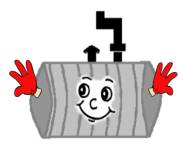Tips From
Frank the Tank

Operation and Maintenance For
Pressurized Piping
|
Tips From Frank the Tank |
|
|
|
Operation and Maintenance For Pressurized Piping |
||
The most frequent Notice of Violations (NOV) issued by BUSTR inspectors is for failure to conduct proper leak detection for piping. These include failure to annually test the operation of the piping leak detector and failure to conduct an annual line tightness test or monthly monitoring for pressure piping. By following the tips offered in the table below, you can ensure that you are properly conducting leak detection for piping.
|
If you have a line
leak detector such as an Automatic Shut-Off Device, Automatic Flow
Restrictor, or a Continuous High Level Audio or Visual Alarm. They may be either mechanical or electrical. |
√ |
Make
sure you annually test your device
and confirm it is working per manufacturer’s requirements. Have
the unit serviced (suggest annually) Do
not ignore or disconnect the alarm |
AND
YOU MUST
|
If you: |
√ |
Make sure you: |
|
Annually
Conduct a Line Tightness Test |
|
Hire a UST tank
tightness tester and do a line tightness test. Results
from an electronic line leak detector may be used if it can detect .1
gallons per hour leak rate. Keep
a record of the results |
|
|
OR |
|
|
Perform
Monthly Monitoring |
|
Monitor
your vapor, groundwater wells, or interstitial (double walled) piping
every 30 days Monthly
SIR may not be used in lieu of tightness testing Keep
a record of the results |
What
to do if your line leak detection alarm goes off?
Treat
the event as if you have had a release of product.
Check
your pipe sump for the presence of petroleum product.
Follow
spill response and reporting requirements if you suspect a release.
Compliance with UST regulations is a
pre-requisite for remaining eligible for Financial Assurance Fund coverage and
claim reimbursement.